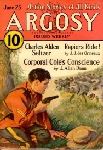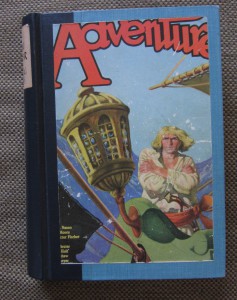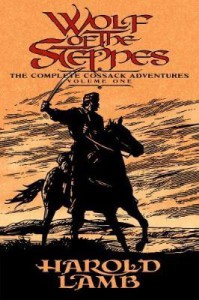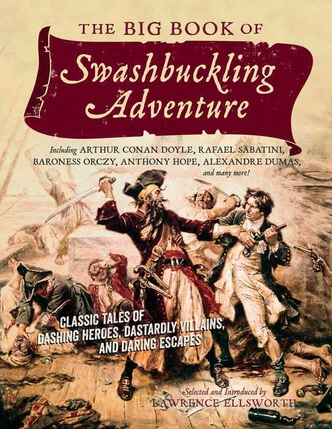Pulp Swashbucklers
 The pulp era began around the turn of the 20th century, in the days before radio and television. Magazines on all sorts of diverting topics were found on the newstands, printed on cheap, pulpy paper, hence the term “pulps.” There was something aimed at almost every reader, rather like all the television shows on cable channels today. And like television today, at least 90% of it was bad. That’s why “pulp fiction” has certain connotations-—cheap, sensationalist, and over-the-top being among them — not to mention “dated” and frequently sexist and politically incorrect. But fiction from this time period should not be dismissed casually — there are treasures there, hidden among all those decades of magazines. The trick is knowing how to find the good stuff, and where to look, and today I thought I’d do my best to guide you to some of the best historical fiction of the pulps.
The pulp era began around the turn of the 20th century, in the days before radio and television. Magazines on all sorts of diverting topics were found on the newstands, printed on cheap, pulpy paper, hence the term “pulps.” There was something aimed at almost every reader, rather like all the television shows on cable channels today. And like television today, at least 90% of it was bad. That’s why “pulp fiction” has certain connotations-—cheap, sensationalist, and over-the-top being among them — not to mention “dated” and frequently sexist and politically incorrect. But fiction from this time period should not be dismissed casually — there are treasures there, hidden among all those decades of magazines. The trick is knowing how to find the good stuff, and where to look, and today I thought I’d do my best to guide you to some of the best historical fiction of the pulps.
 The pulp historical fiction of the early twentieth century (circa 1915-1940) has many of the same elements of good fantasy fiction. In place of the imaginary land is a distant era that, in the hands of the better writers, sparkles with more power than many an invented setting. There are heroes who must live by their wit and weapon skills in deadly borderlands, beset by schemers and intriguers. There is treasure to be found, and ancient secrets, and lovely women: some are old-fashioned damsels in distress, but others are keen-eyed adventurers and daring women ahead of their time. There are loyal comrades, implacable foes, powerful but foolish kings, secret societies, fabulous kingdoms, and those who pass themselves off as wizards and miracle workers. In short, if you read the sword and sorcery writers and the pulp historical fiction writers, the lineage is obvious–their stories are fashioned with the same spirit, from love of the same plot elements.
The pulp historical fiction of the early twentieth century (circa 1915-1940) has many of the same elements of good fantasy fiction. In place of the imaginary land is a distant era that, in the hands of the better writers, sparkles with more power than many an invented setting. There are heroes who must live by their wit and weapon skills in deadly borderlands, beset by schemers and intriguers. There is treasure to be found, and ancient secrets, and lovely women: some are old-fashioned damsels in distress, but others are keen-eyed adventurers and daring women ahead of their time. There are loyal comrades, implacable foes, powerful but foolish kings, secret societies, fabulous kingdoms, and those who pass themselves off as wizards and miracle workers. In short, if you read the sword and sorcery writers and the pulp historical fiction writers, the lineage is obvious–their stories are fashioned with the same spirit, from love of the same plot elements.
Historical fiction wasn’t the mainstay of the pulps–for the most part westerns and detective fiction were–but many an author wrote “costume pieces.”
The pulps saw the engaging though repetitious exploits of Zorro, and printed the adventures of Sabatini’s Captain Blood. Many today may not know that so famous a character as Horatio Hornblower first made his appearance in the pulp magazines.
But there are other authors, popular in their time, now nearly forgotten. There was H. Bedford-Jones, that most prolific of pulp authors (said to write a million words a year) who could be relied upon for tales of the high seas and cavaliers and Dumas-like action. (He even wrote an authorized Three Musketeers sequel!)
Arthur Gilchrist Brodeur and Farnham Bishop, writing together or separately, could be counted on for exciting tales of clashing arms and mayhem set in the distant past. Their style is sometimes slow, weighted with the pacing of the nineteenth century, yet they should not be too easily disregarded; sometimes their work springs with amazing vigor. One of the best by either man is a neglected gem of Viking adventure, originally serialized in Argosy beginning in November of 1928. Sadly, it has never seen reprint, although Black Dog Books has it on the docket. Here’s a brief look at He Rules Who Can, a novel by Arthur Gilchrist Brodeur:
Suddenly Cyra shrieked. Wheeling, tugging at his ax, Harald felt her snatched from him. Even as he got his weapon clear, a knife smashed against the mail above his ribs.
Cyra was struggling in the grasp of two men. The crowds about them had vanished as if by magic at the first outcry, leaving the two surrounded by cloaked figures. Whirling his ax, Harald leaped for the two who held the girl. Instantly four men flung themselves in his way, short swords out-thrust.
Arthur D. Howden Smith crafted many a bold tale, among them the saga of the Viking Swain, and the story of Gray Maiden.
Gray Maiden was a sword first forged for a Pharaoh. In each story the blade is wielded by a different warrior, down through history. The sword is sometimes lost or entombed with its wielder, but always it is unearthed to wreak more mischief. It is a supremely sharp blade with supernatural powers—no man who bares her meets his death by sword, though they often perish in other ways.
The Gray Maiden story cycle veers widely in quality. Some portions are full of monotonous talking heads, whereas some are truly outstanding–“Thord’s Wooing” [1927] is an excellent Viking tale. A scene late in the story in the midst of a duel provides some sense of its flavor. Bjarni, mortally wounded, seeks to take the life of Thord’s mother, Elin.
“Your doing, witch,” He gasped. “Come with me!”
And he hurled his sword straight at her breast. It turned once in the air, hilt over point, a flash of light in the dimness, sped by the last strength of his body even as he collapsed in death. But Grey Maiden flew faster. Thord cast the long blade like an axe, and once more it parried Bjarni’s blow. The two swords clattered at Elin’s feet.
 And you need not think that the pulps were the exclusive province of male writers, even if they were the dominant presence. I’m sure most visitors to this site know that later pulp writers like Leigh Brackett and C.L. Moore were women (…and outside the scope of this historical article, as they were writing space opera/sword-and-planet). But how many of you have read anything by Marion Polk Angellotti, who wrote a series of swashbucklers based on the exploits of a real mercenary company of the 14th century, led by the astonishing Sir John Hawkwood? Are you familiar with G.G. Pendarves, who wrote adventures set in the middle-east for both Weird Tales and Magic Carpet magazine?
And you need not think that the pulps were the exclusive province of male writers, even if they were the dominant presence. I’m sure most visitors to this site know that later pulp writers like Leigh Brackett and C.L. Moore were women (…and outside the scope of this historical article, as they were writing space opera/sword-and-planet). But how many of you have read anything by Marion Polk Angellotti, who wrote a series of swashbucklers based on the exploits of a real mercenary company of the 14th century, led by the astonishing Sir John Hawkwood? Are you familiar with G.G. Pendarves, who wrote adventures set in the middle-east for both Weird Tales and Magic Carpet magazine?
There are other fine authors and other fine tales, but two giants stride out of this field, authors famed for both quality and quantity. Both of them influenced Robert E. Howard, the father of modern sword-and-sorcery. They were Talbot Mundy and Harold Lamb.
Mundy’s real name was William Lancaster Gribbon, and before he took up writing he’d knocked about India and East Africa and Germany and nearly gotten himself killed several times over. It was while recovering in the hospital after getting blackjacked that he took up writing.
Talbot Mundy is best known for two series characters, James Grim, or Jim Grim, an American adventurer working for the British Secret Service, and Tros of Samothrace, but he wrote other tales besides
It is Tros who concerns us here. This long cycle of stories was published for the most part as a series of novellas in the pages of Adventure magazine (a novel near the end of the cycle appeared in book form). And if any fiction decries its “pulp” reputation, it is Mundy’s Tros of Samothrace. Mundy was a skilled student of human nature with philosophical leanings. His characters are rich, complex, and well drawn. His plots are hinged upon the actions taken by his heroes and villains. Sometimes the stories unfold slowly, because they are dependent upon intrigue, politics, and dialogue, but at the appropriate moments they explode with action. They are not “talky,” however–once you are involved with the characters you linger over every word.
Above all, Mundy was a careful craftsman. Consider the somber tone of the following scene from Tros of Samothrace, hardly expected of a typically garish pulp writer:
He went below, into the cabin where his father’s body lay, with Caesar’s scarlet cloak spread over it. And for a while he stood steadying himself with one hand on an overhead beam, watching the old man’s face, that was as calm as if Caesar’s tortures had never racked the seventy-year-old limbs, the firm, proud lip showing plainly through the white beard, the eyes closed as in sleep, the aristocratic hands folded on the breast.
It was dark in there and easy to imagine things. The body moved a trifle in time to the ship’s swaying.
Tros is a skilled sailor and minor initiate into an ancient and widespread mystical society, which Mundy renders entirely believable. His greatest desire is to build the ship of his dreams and sail around the world (for his people know the Earth is round) but before he can do either he runs afoul of Caesar’s ambitions. Caesar is one of Mundy’s triumphs—a rascal genius who only fails because his ego eventually grows too large. His character is depicted brilliantly.
Tros does eventually build his ship, ends up allied with Cleopatra and even, near the end, aids his old enemy Caesar. He never does manage to sail around the world, though Mundy fully planned to write that story, because his creator died of diabetes before pen went to paper. Fortunately the series ends on a completed note, with all of the hero’s Mediterranean adventures resolved.
the world, though Mundy fully planned to write that story, because his creator died of diabetes before pen went to paper. Fortunately the series ends on a completed note, with all of the hero’s Mediterranean adventures resolved.
Harold Lamb was a quiet man who was fascinated with chronicles of eastern history at an early age. Later he would create the epic Durandal trilogy, amongst other thrilling Crusader novels; later he would become a renowned historian and wealthy screenwriter, penning more than thirty movies for Cecil B. DeMille. First, though, he created a cycle of remarkable historical fiction stories set in locations as fabulous and unfamiliar to most readers as Burroughs’ Mars.
Where many adventure tales are predictable from the first word, Lamb’s plots were full of unexpected twists. He wrote convincingly of faraway lands and dealt fairly with their inhabitants, relating without bias the viewpoints of Mongols, Moslems, and Hindus. His stories are rarely profound psychological drama, but Lamb nonetheless breathed humanity into his characters, endowing them with realistic hopes and fears. Unlike almost all of his predecessors and many of his contemporaries, the pacing of most of his historicals still feels modern–he never stopped for slow exposition. His plots thunder forward as though he envisioned each one for cinema the moment he slid paper into the typewriter.
The most enduring and complex of all Lamb’s heroes was his first, Khlit the Cossack. Before Stormbringer keened in Elric’s hand, before the Gray Mouser prowled Lankhmar’s foggy streets—before even Conan trod jeweled thrones under his sandaled feet, Khlit the Cossack rode the steppe. He is the forgotten grandfather of all series sword-and-sorcery characters.
The Cossack is already old when his saga begins, late in the 16th century in the grasslands of central Asia. He is an expert horseman and swordsman, unlettered and only a step removed from barbarism, but wise in the ways of war and men. Gruff and taciturn, Khlit is a firm believer in justice and devout in his faith, though not given to prayer or religious musings. He is the friend and protector of many women, but leaves romance to his sidekicks and allies.
 The stories swim in action, treachery — and places best unglimpsed by mortal men. Consider the following scene, from the novella “The Mighty Manslayer.” [1918]
The stories swim in action, treachery — and places best unglimpsed by mortal men. Consider the following scene, from the novella “The Mighty Manslayer.” [1918]
Mir Turek caught his arm and pointed to the further side.
“The Bearers of Wealth!” he screamed. “See, the Bearers of Wealth, and their burden. The Tomb of Genghis Khan. We have found the tomb of Genghis Khan!”
The shout echoed wildly up the cavern, and Khlit thought that he heard a rumbling in the depths of the cavern in answer. He looked where Mir Turek pointed. At first he saw only the veil of smoke. Then he made out a plateau of rock jutting out from the further side. On this plateau, abreast of them, and at the other end of the rock bridge gigantic shapes loomed through the vapor. Twin forms of mammoth size reared themselves, and Khlit thought that they moved, with the movement of the vapor. These forms were not men but beasts that stood side by side. Between them they supported a square object which hung as if suspended in the air.
Throughout the seventeen part series Khlit yearns for far horizons and strange new sights. He rides alone for a time before rising to lead a Tatar tribe for five tales, then later joins forces with the heroic Afghan swordsman and Moslem, Abdul Dost. Always Khlit bears his famed curved saber, gilt with the writing of an unknown tongue. It is a deadly blade with its own secret history, disclosed as the series progresses.
The Khlit saga is a remarkable tour de force, and any reader who has loved the works of Robert E. Howard and Fritz Leiber and those who followed them will embrace the stories of the wily old Cossack—and other Lamb stories besides.
Speaking of Robert E. Howard, some of his very best work are his historicals. Given his druthers, that’s what he would have been writing, but he never did crack Adventure or Argosy with his historical fiction. As a result, he didn’t write that much in the genre, but most of what he did draft was penned at the very top of his game.
Finding the Fiction
 When I began my exploration of pulp magazine fiction I assumed that all the best work had already been collected and reprinted and that mostly dross remained. I had also assumed that finding the stories located in pulps would be a simple matter-—that probably, as with National Geographic, the old issues would be available on collections of CD-ROMs.
When I began my exploration of pulp magazine fiction I assumed that all the best work had already been collected and reprinted and that mostly dross remained. I had also assumed that finding the stories located in pulps would be a simple matter-—that probably, as with National Geographic, the old issues would be available on collections of CD-ROMs.
I could not have been more wrong. Few of the pulps are indexed at all. Even pulp magazines like the influential Weird Tales and Adventure, once hailed by Newsweek as the dean of pulp magazines, are un-indexed in that sacred cow, the Reader’s Guide to Periodical Literature. Naturally this makes finding specific stories or magazine issues quite challenging. There exist only a few indexes to a tiny number of pulp magazines, and only because of the efforts of a few dedicated collectors. A handful of libraries and universities are amassing pulp magazine collections, but the pulps are aging and crumbling away.
 If you’re looking for analysis or discussion of this fiction, you can turn to the sixth volume of Robert Sampson’s history of pulp characters, Yesterdays Faces: Violent Lives. Sampson discusses Mundy, Lamb, and others at length. Robert Kenneth Jones’ Lure of Adventure discusses historical fiction from that famous magazine.
If you’re looking for analysis or discussion of this fiction, you can turn to the sixth volume of Robert Sampson’s history of pulp characters, Yesterdays Faces: Violent Lives. Sampson discusses Mundy, Lamb, and others at length. Robert Kenneth Jones’ Lure of Adventure discusses historical fiction from that famous magazine.
If it’s the fiction itself you’re after, you’re in much better shape than you were ten years ago when I wrote my first draft of this article. For instance, here at last are ALL of the Gray Maiden stories, collected in a single volume. No longer do you need to haunt used book search services to find a selection of the tales. Howden-Smith’s multi-part Swain’s Saga, alas, still remains uncollected in its entirety.
Tros of Samothrace is now available in several formats through several companies. A quick search on Amazon turned all of these up.
 And of course nearly all of Harold Lamb’s best swashbucklers have been assembled through the University of Nebraska Press’ Bison Books imprint, scanned, compiled, and edited by yours truly. Here’s a link.
And of course nearly all of Harold Lamb’s best swashbucklers have been assembled through the University of Nebraska Press’ Bison Books imprint, scanned, compiled, and edited by yours truly. Here’s a link.
As for the more familiar authors, most libraries still have copies of at least some portions of C.S. Forrester’s Hornblower series and are likely to have a few Rafael Sabatini books on their shelves.
Until recently the original Zorro has been hard to find. All of the stories have recently been collected by Pulp Adventures. You can find the first through Amazon, and more may already be in print. Look for Zorro : The Masters Edition Vol. One.
But there are even more riches out there. Those curious about H. Bedford-Jones, Arthur D. Howden Smith, or others need look no further than Black Dog Books or Wildside Press. For instance, Wildside is offering “megapacks” of various authors, or even subjects (like pirates) for absurdly low prices. So long as you have an e-book reader, you may be in pulp heaven. I’ve personally found H. Bedford-Jones always a little hit and miss, but at .99 cents it’s a heckuva chance to try him out, and a good chance to get the hits and not mind the misses.
 Bolstered as it is by multiple pulp scholars (among them owner Tom Roberts and frequent co-editor Doug Ellis) Black Dog Books has a deserved reputation for quality. For starters, Ellis is masterminding a “Best of” collection of Adventure magazine. So far, two volumes are available, but he recently wrote me that the next two are just about ready for press. But that’s not all — Black Dog Books is also reprinting Bedford-Jones, Bishop & Brodeur, and even more obscure historical writers — and “obscure” in this instance doesn’t mean bad. If this stuff is your cup of tea, I strongly suggest you wander through their fiction line. Make sure you look at their “Coming Soon” and “Also in Production” sections, where you’ll find even more great looking stuff, including the aforementioned novel by Bishop & Brodeur, He Rules Who Can. And Black Dog has collected all Angelloti’s tales of Sir John Hawkwood, as well as all of G.G. Pendarves’ stories!
Bolstered as it is by multiple pulp scholars (among them owner Tom Roberts and frequent co-editor Doug Ellis) Black Dog Books has a deserved reputation for quality. For starters, Ellis is masterminding a “Best of” collection of Adventure magazine. So far, two volumes are available, but he recently wrote me that the next two are just about ready for press. But that’s not all — Black Dog Books is also reprinting Bedford-Jones, Bishop & Brodeur, and even more obscure historical writers — and “obscure” in this instance doesn’t mean bad. If this stuff is your cup of tea, I strongly suggest you wander through their fiction line. Make sure you look at their “Coming Soon” and “Also in Production” sections, where you’ll find even more great looking stuff, including the aforementioned novel by Bishop & Brodeur, He Rules Who Can. And Black Dog has collected all Angelloti’s tales of Sir John Hawkwood, as well as all of G.G. Pendarves’ stories!
If you’re looking for a sampler of this sort of thing– perhaps a very large one — you’ll be in good hands with Lawrence Ellsworth’s Big Book of Swashbucklers, described in detail over at Black Gate.
 I’ve mentioned both Wildside and Black Dog Books, and I’d be remiss not to mention Altus Press as well. Although they primarily focus on mystery and adventure (and are doing a sterling job reprinting lost noir writer Frederick Nebel), a quick look through the Altus catalog will show you a handful of swashbucklers, including the complete run of Theodore Roscoe’s French Foreign Legion stories.
I’ve mentioned both Wildside and Black Dog Books, and I’d be remiss not to mention Altus Press as well. Although they primarily focus on mystery and adventure (and are doing a sterling job reprinting lost noir writer Frederick Nebel), a quick look through the Altus catalog will show you a handful of swashbucklers, including the complete run of Theodore Roscoe’s French Foreign Legion stories.
Lastly, it’s probably no secret to regular visitors that I got to pen the afterword to the Del Rey Robert E. Howard historical collection, Sword Woman, available now through Del Rey (and my pal Scott Oden got to write the introduction!).
Probably I’ve left off some other publishers and some other works, but hopefully I’ve given you a good starting point for exploration, or, if you’re already into this sort of thing, expanded your horizons. If you hear of any other publishers or pulp historical writers that need mention, don’t hesitate to write me. I can add them in to this very article, or cover them separately later.
21 Comments